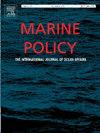Beyond numbers: Assessing staff capacity and competence in the management of Indonesian marine protected areas
IF 3.7
2区 社会学
Q2 ENVIRONMENTAL STUDIES
引用次数: 0
Abstract
Indonesia, recognized as a global marine biodiversity hotspot, has rapidly expanded its Marine Protected Area (MPA) network. However, management effectiveness continues to face challenges, partly due to limited staff capacity. This study presents the first evaluation of staff capacity in Indonesian MPAs, examining organizational structures, role clarity, required competencies, and staffing adequacy across 36 priority MPAs. Using document reviews, questionnaires, and focus group discussions, we found overlapping roles, broad job descriptions, and a mismatch between existing competencies and operational needs. Over two-thirds of the MPAs fell below the baseline of eight staff, and only three MPAs met the recommended staffing level of twenty staff to allow effective operations. Surprisingly, staff numbers were not correlated with MPA size and ecological characteristics (coverage of coral, seagrass, and mangrove), though they were positively associated with cumulative human pressure. Our analysis identified 20 role-specific competencies, four of which are not covered by the national certification scheme. Recognizing that each MPA has unique ecological characteristics, socioeconomic contexts, and management complexities makes staffing targets difficult to apply uniformly. Nevertheless, our proposed benchmarks offer a pragmatic reference to support planning and resource allocation when adapted to site-specific needs. Our results underscore the need for a structured, competency-based staffing strategy tailored to local contexts. We recommend establishing clear roles and job descriptions, aligning competencies with management needs, while also fostering partnerships with NGOs and local governments. These findings support Indonesian MPA planning and offer a scalable model for achieving SDG 14 and the '30 by 30' commitment globally.
超越数字:评估印尼海洋保护区管理工作人员的能力和能力
作为全球公认的海洋生物多样性热点国家,印度尼西亚迅速扩大了其海洋保护区网络。然而,管理效率继续面临挑战,部分原因是工作人员能力有限。本研究首次评估了印度尼西亚海洋保护区的工作人员能力,审查了36个优先海洋保护区的组织结构、角色清晰度、所需能力和人员配备充足性。通过文档审查、问卷调查和焦点小组讨论,我们发现了重叠的角色、宽泛的工作描述,以及现有能力和操作需求之间的不匹配。超过三分之二的海洋保护区低于八名工作人员的基线,只有三个海洋保护区达到建议的20名工作人员的员额水平,以便有效开展业务。令人惊讶的是,工作人员数量与海洋保护区大小和生态特征(珊瑚、海草和红树林的覆盖率)没有相关性,尽管它们与累积的人类压力呈正相关。我们的分析确定了20个角色特定能力,其中4个不包括在国家认证计划中。认识到每个MPA具有独特的生态特征、社会经济背景和管理复杂性,使得人员配置目标难以统一适用。尽管如此,我们提出的基准为支持规划和资源分配提供了实用的参考,当适应特定的场地需求时。我们的研究结果强调,需要根据当地情况制定结构化的、以能力为基础的人员配置战略。我们建议建立明确的角色和工作描述,使能力与管理需求保持一致,同时促进与非政府组织和地方政府的伙伴关系。这些发现为印尼的海洋保护区规划提供了支持,并为实现可持续发展目标14和全球“30 by 30”承诺提供了可扩展的模式。
本文章由计算机程序翻译,如有差异,请以英文原文为准。
求助全文
约1分钟内获得全文
求助全文
来源期刊

Marine Policy
Multiple-
CiteScore
7.60
自引率
13.20%
发文量
428
期刊介绍:
Marine Policy is the leading journal of ocean policy studies. It offers researchers, analysts and policy makers a unique combination of analyses in the principal social science disciplines relevant to the formulation of marine policy. Major articles are contributed by specialists in marine affairs, including marine economists and marine resource managers, political scientists, marine scientists, international lawyers, geographers and anthropologists. Drawing on their expertise and research, the journal covers: international, regional and national marine policies; institutional arrangements for the management and regulation of marine activities, including fisheries and shipping; conflict resolution; marine pollution and environment; conservation and use of marine resources. Regular features of Marine Policy include research reports, conference reports and reports on current developments to keep readers up-to-date with the latest developments and research in ocean affairs.
 求助内容:
求助内容: 应助结果提醒方式:
应助结果提醒方式:


